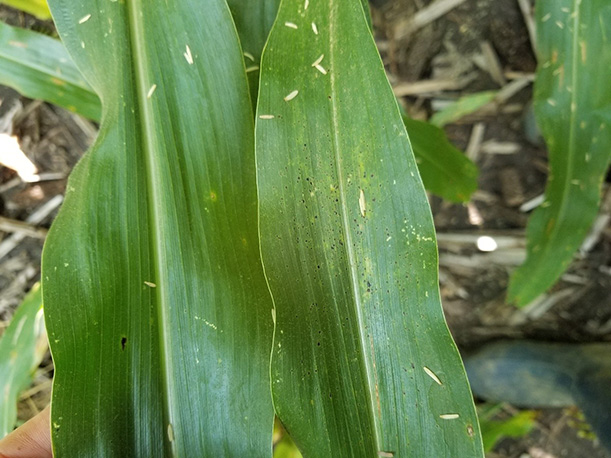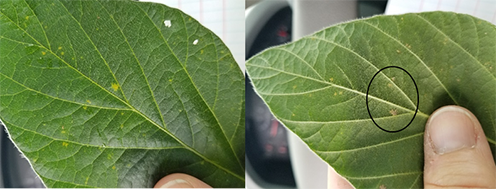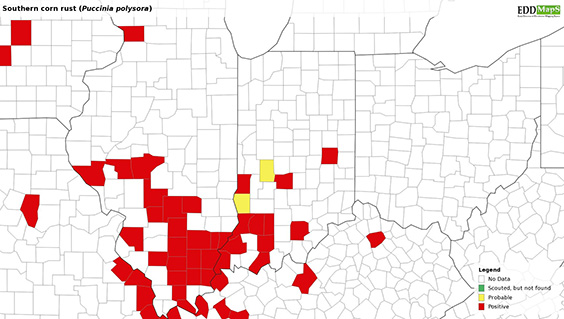Corn
Southern Rust is now confirmed in 11 counties in Indiana (figure 1). These include Daviess, Dubois, Gibson, Henry, Knox, Martin, Morgan, Posey, Spencer, Vigo and Washington counties and suspected in Sullivan and Putnam. Keep scouting and if you suspect it, please send a sample to the Purdue Plant Pest Diagnostic Lab (PPDL). Southern corn rust does not over winter in Indiana. The spores are blown-up on weather systems from tropical regions each year – for up to date information the https://corn.ipmpipe.org/southerncornrust/ website is tracking the movement.
Southern corn rust is generally not an annual problem in Indiana, except when it arrives earlier in the season (like this year) and/or we have a delayed crop (again like this year). Southern rust can cause significant yield loss if it builds up to high levels during silking and corn fill. Therefore, it is very important to keep a close eye out for this disease this season to make timely management decisions. Check out following southern rust publication for more images of southern rust and other diseases that might mimic it at https://crop-protection-network.s3.amazonaws.com/publications/cpn-2009-southern-rust.pdf.
Tar Spot – we are starting to find tar spot around the region. Thus far in the 2019 season, it is has been found active in field in five counties with a previous history, Elkhart, Kosciusko, LaPorte, Porter, Pulaski, and St. Joseph (figure 2). We have seen variable symptoms from a few stroma on a leaf to many (figure 3). We again are requesting if you have any suspect locations to please update us and send a sample. I am especially interested in surrounding counties such as Lake, Jasper, Fultop, Marshal, Lagrange, Steuben, Noble, DeKalb, and Starke or anything in the northern part of Indiana. See this link on a short guide to collecting. https://extension.purdue.edu/fieldcroppathology/wp-content/uploads/2019/07/Please-Help-Us-Collect-Field-Crop-Disease-Samples.pdf.

Figure 3. An example of a leaf with just one tar spot stroma (left) and a leaf with multiple stroma (right). (Photo Credit: Darcy Telenko)
Soybeans
We are starting to find a few foliar diseases in soybean in Indiana.
Downy mildew caused by Peronospora manshurcia is commonly found on soybean but rarely causes serious yield loss. Symptoms appear as irregularly shaped, pale green to light yellow spots. If you flip the leaf over you will likely see the distinctive sporulation on the underside, (see figure 4). Older lesions will turn brown with yellow-green margins.

Figure 4. Downy mildew symptoms on upper leaf – pale green to light yellow spots and the underside showing the sporulation. (Photo Credit: Darcy Telenko)
Frogeye leaf spot caused by Cercospora sojina is a foliar disease can cause significant yield losses. We have started to find a few frogeye lesions in our soybean sentinel and research trials locations (see figure 5).
Management practices for frogeye are aimed reducing soybean susceptibility and inoculum availability. Infected debris from previous crops is the primary source of inoculum for this disease. Any practice that helps reduced or bury the infected residue will help reduced inoculum in a field such as fall tillage or soybean- corn crop rotation. There are a number of varieties available with frogeye resistance. Fungicide spray application after growth stage R1 can reduced severity, while applications made at R3 are considered most effective for frogeye. There are number of fungicides available to use for frogeye management. The North Central Regional Committee on Soybean Diseases (NCERA-137) annually releases foliar fungicide efficacy tables for control of the major foliar soybean diseases in the US. This resource is found at the following link: https://crop-protection-network.s3.amazonaws.com/publications/fungicide-efficacy-for-control-of-soybean-foliar-diseases-filename-2019-03-25-121546.pdf.





